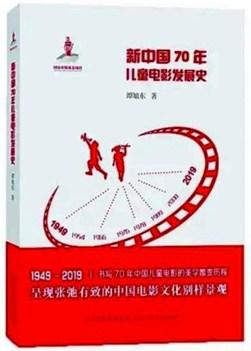
. > WHAT'S NEW > BOOKS
Children’s films over the past 70 years
Author : CHEN XUGUANG and LIU YIYI Source : Chinese Social Sciences Today 2020-11-25

The History of Children’s Films in China (1949–2019)
Since A Naughty Kid, the first children’s film in China, was released in 1922, children’s films have grown from pioneering to diverse in the past century.
The History of Children’s Films in China (1949–2019), written by Tan Xudong, a professor from the College of Liberal Arts at Shanghai University, combines specific film texts and makes a detailed analysis of the history, development, inheritance, and current situation of children’s films in China, from the perspectives of historical backgrounds, cultural contexts, creative ideas, filming methods, and dissemination characteristics.
Tan divides the development of Chinese children’s films from 1922 to 2019 into five stages, the first stage was before the establishment of the People’s Republic of China in 1949. These stages show the progress and innovation of production concepts, expression techniques, and technological means for children’s films. These stages also reflect how children’s films gradually take on complex and diverse artistic approaches in the process of transforming production systems, movie functions, communication targets, economic systems, and media environments.
By focusing on the last four stages, the author argues that the concepts in children’s movies have shifted from instrumental concepts promoting “informative and educative values that outweigh aesthetic values in literature and art” during the early period of the PRC, to “the functionalization of publicity,” and beyond, into “the child-centered concept.” Images of children have also changed from characters who were oriented towards adults and revolutionization such as Pan Dongzi in Sparkling Red Star and Zhang Ga in Zhang Ga the Soldier Boy, to more diverse characters such as children of ethnic minorities and children with physical disabilities.
After comparing children’s films in different periods, the author points out that the aesthetic style of children’s films has gradually become dominated by realism, and the main aesthetic trend is “suffering beauty” intertwined with “poetic beauty.”
In addition, driven by the reform and opening up as well as the market economy, the change in cultural contexts has expanded the scope of selectable topics. This has led to the transition of themes in children’s movies from simplification to diversification, as seen in biographical films, science fiction, fantasy, and films set in rural areas. Children’s fantastic thinking, emotional development, and confusion regarding their growth process are recorded on the big screen.
This article was edited and translated from Guangming Daily.
Ye Shengtao made Chinese fairy tales from a wilderness
Ye Shengtao (1894–1988) created the first collection of fairy tales in the history of Chinese children’s literature...
-
How northern ethnicities integrated into Chinese nation
2023-09-18
-
Mogao caves
2023-09-12
-
Mogao Grottoes as ‘a place of pilgrimage’
2023-09-12
-
Time-honored architectural traditions in China
2023-08-29
-
Disentangling the civilizational evolution of China
2023-08-28
-
AI ethics in science fiction
2023-08-23













 2011-2013 by www.cssn.cn. All Rights Reserved
2011-2013 by www.cssn.cn. All Rights Reserved